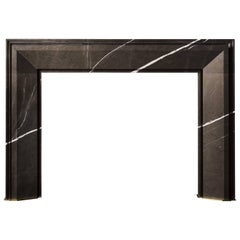Pembrooke And Ives
Recent Sales
21st Century and Contemporary European Modern Fireplaces and Mantels
Limestone, Brass
A Close Look at modern Furniture
The late 19th and early 20th centuries saw sweeping social change and major scientific advances — both of which contributed to a new aesthetic: modernism. Rejecting the rigidity of Victorian artistic conventions, modernists sought a new means of expression. References to the natural world and ornate classical embellishments gave way to the sleek simplicity of the Machine Age. Architect Philip Johnson characterized the hallmarks of modernism as “machine-like simplicity, smoothness or surface [and] avoidance of ornament.”
Early practitioners of modernist design include the De Stijl (“The Style”) group, founded in the Netherlands in 1917, and the Bauhaus School, founded two years later in Germany.
Followers of both groups produced sleek, spare designs — many of which became icons of daily life in the 20th century. The modernists rejected both natural and historical references and relied primarily on industrial materials such as metal, glass, plywood, and, later, plastics. While Bauhaus principals Marcel Breuer and Ludwig Mies van der Rohe created furniture from mass-produced, chrome-plated steel, American visionaries like Charles and Ray Eames worked in materials as novel as molded plywood and fiberglass. Today, Breuer’s Wassily chair, Mies van der Rohe’s Barcelona chair — crafted with his romantic partner, designer Lilly Reich — and the Eames lounge chair are emblems of progressive design and vintage originals are prized cornerstones of collections.
It’s difficult to overstate the influence that modernism continues to wield over designers and architects — and equally difficult to overstate how revolutionary it was when it first appeared a century ago. But because modernist furniture designs are so simple, they can blend in seamlessly with just about any type of décor. Don’t overlook them.
Materials: brass Furniture
Whether burnished or lacquered, antique, new and vintage brass furniture can elevate a room.
From traditional spaces that use brass as an accent — by way of brass dining chairs or brass pendant lights — to contemporary rooms that embrace bold brass decor, there are many ways to incorporate the golden-hued metal.
“I find mixed metals to be a very updated approach, as opposed to the old days, when it was all shiny brass of dulled-out silver tones,” says interior designer Drew McGukin. “I especially love working with brass and blackened steel for added warmth and tonality. To me, aged brass is complementary across many design styles and can trend contemporary or traditional when pushed either way.”
He proves his point in a San Francisco entryway, where a Lindsey Adelman light fixture hangs above a limited-edition table and stools by Kelly Wearstler — also an enthusiast of juxtapositions — all providing bronze accents. The walls were hand-painted by artist Caroline Lizarraga and the ombré stair runner is by DMc.
West Coast designer Catherine Kwong chose a sleek brass and lacquered-parchment credenza by Scala Luxury to fit this San Francisco apartment. “The design of this sideboard is reminiscent of work by French modernist Jean Prouvé. The brass font imbues the space with warmth and the round ‘portholes’ provide an arresting geometric element.”
Find antique, new and vintage brass tables, case pieces and other furnishings now on 1stDibs.
Finding the Right fireplaces-mantels for You
While we likely wouldn’t mourn the invention of home heating and air-conditioning, these innovations did tragically reduce the widespread need for fireplaces and mantels in our living rooms.
Once an essential fixture in all homes, the fireplace, which, along with the chimney, is as old as the Middle Ages, was actually rendered redundant with the advent of the cast-iron heating stove during the 18th century. Victorian-era heating stoves were popular in the common areas of a living space for their capacity to heat as well as for their lack of smoke compared to fireplaces. However, improvements in craftsmanship as well as the Industrial Revolution meant that fireplaces were evolving in form and functionality.
Even as HVAC systems would eventually see to it that fireplaces weren’t a necessity, no mechanically engineered thermal heating and ventilation technology can replicate the feeling of warmth and camaraderie that a flickering fire guarantees. We just love a good fireplace.
“With antique fireplaces, you get heart, soul, character and architecture,” says Tony Ingrao, a Manhattan-based interior designer who purchased an important 16th-century French limestone fireplace for a client’s Greenwich Village townhouse.
Vintage fireplaces and mantels have earned their coveted position as desirable focal points in any room over the course of a staggering evolution in design that has yielded everything from intricately carved works of limestone to sleek works of wood paneling and rolled steel.
As log after log turns into ash, these iconic designs prove their timelessness and value, monetarily and as prized decorative monuments. Whether you seek to simply warm a space or completely transform it, an eye-catching new mantel for your blazing hearth — be it an elegant neoclassical design, a marvelous work of marble in the Louis XV style or an unconventional contemporary variation — is the perfect solution.
Find a collection of antique and vintage fireplaces and mantels on 1stDibs today.
